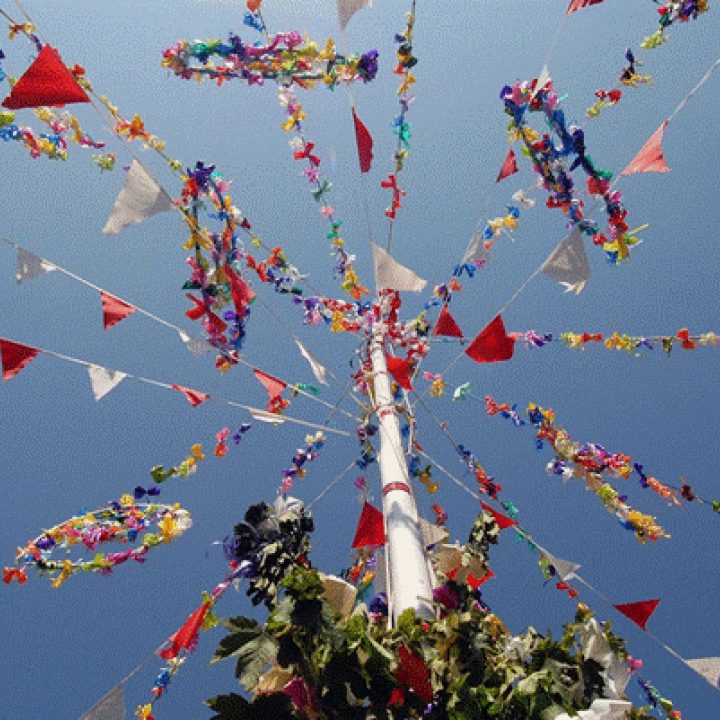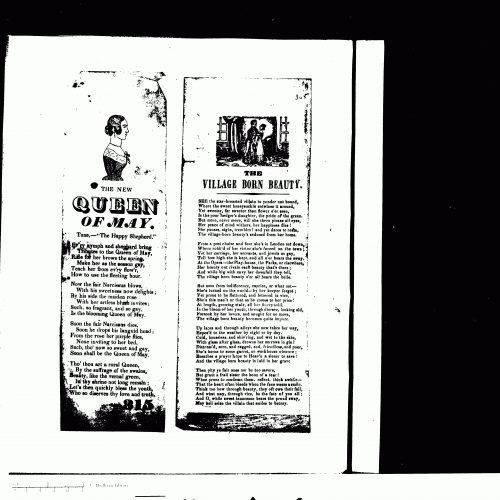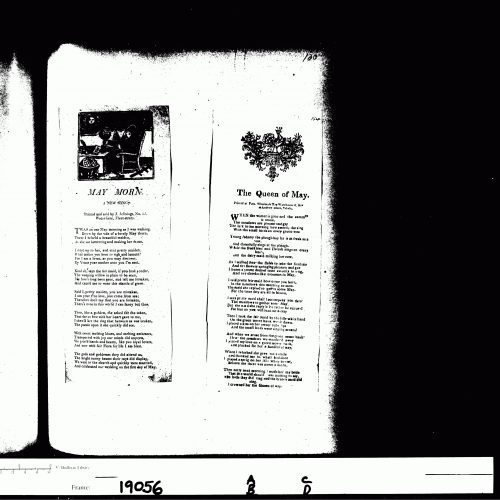May Day is a day to celebrate. Across the world there are many different celebrations held on this day;
pagan, catholic, socialist, but they all involve singing and dancing and connecting with community.
As this is TradSongTues we’ll concentrate on the music, dancing and community and less on the traditions behind the celebrations although there are some links throughout where more of the histories of the May Day celebrations can be found.
In England, the festival of May Day is a celebration of new life, Spring becoming Summer, fertility. It is also a day to celebrates workers’ rights, in the way that Labour Day does elsewhere in the world. As a day that is a holiday for everyone, not specifically linked to a religious festival, it is a time for community celebration and this is expressed in different ways across the country.
Obby Oss, Padstow
In Padstow, Cornwall, there is an annual festival to welcome in the Spring with the dancing of an ‘Obby ‘Oss through the town. This is an ancient festival and has been extensively recorded and written about. The following information was taken from the Mainly Norfolk website.
‘A 1945 BBC original recording of the Padstow May Day Song sung by a crowd with accordion and drum has been included in the Alan Lomax collection CD World Library of Folk and Primitive Music: England. The liner notes say:
When the town clock of Padstow strikes midnight on April 30th, there begins a ceremony which is one of the most remarkable pagan survivals in England. Between 12 and 2 a.m. the hobby horse committee walk through streets and gardens singing the May Day Song. Then, next day, the hobby horse dancer appears. He wears a six-foot hoop skirt, painted shiny black and reaching to the ground. This hoop rests on his shoulders, and his head is covered in a conical black mask on which a sinister face is painted in black and white.
At about 11 a.m. this rather terrifying creature emerges from the Golden Lion Inn, accompanied by the “Old 'Oss Committee,” generally in sailor costume, an orchestra of drums and accordions, a man with a box for voluntary collections, and the teaser, who dances nimbly in front of the horse, directing his movements with the manipulation of a phallic club. All day this strange procession roves through Padstow, singing:
Unite and unite, and let us all unite
For summer is a-comin' today.
And whither we are going we all will unite
In the merry morning of May.
The hoss visits the sick. Children come shyly to touch the skirt for luck. Young married women, caught up under the hoss's shirt, will, according to old Padstonians, give birth within the year. And then, every so often, the surging dance rhythm ceases with a sudden bang of the drum. The hoss bows down motionless to the ground, and, while the teaser makes caressing movements with his symbolic club, the crowd sings a solemn dirge, in which some scholars have found a garbled reference to the Norse goddess, Freya, and her long ship.
Oh where is King George? Oh where is he O?
He's out in the longboat, all on the salt sea O.
Up flies the kite, down falls the lark O.
Aunt Ursula Birdwood she has an old ewe,
And she died in her own park O.
With a thwack of the club and a crash of the drums the hoss suddenly leaps up, revived; and the singing throng moves on beneath the springtime blossoms.’
What follows is footage collected by Alan Lomax in 1953 including the singing of the May Song:
This link is of the modern-day equivalent from 2019 showing very much the same event.
May Day Morris Dancing
The tradition of Morris dancing at dawn on May Day to welcome in the Summer and make sure the sun continues to rise still goes on today. Below is a link to Sheffield’s Pecsaetan Morris dancing out on the morning of May 1st 2015.
The pandemic has had an enormous effect on all the folk arts but Pecsaetan Morris beat the lockdown blues on May 1st
2020 by dancing at dawn individually. The result is moving. As with so many of the pandemic online arts projects this one shows an indomitable spirit and a connection to the rhythms of nature that cannot be ignored.
The songs performed here are Hal-an-Tow sung by Pete Delamare and The Swinton May Song sung by Richard and Jess Arrowsmith. The title Hal-An-Tow is translated differently in different geographical areas, as can be seen by a quick search on the internet, however the relevance of the words to a celebration of the season is clear. There are many different verses added in and taken out depending on which part of the country the song is sung but below are the words as sung here.
Hal-An-Tow
Take the scorn to wear the horn
It was the crest when you were born
Your father's father wore it
And your father wore it too
Chorus (after each verse):
Hal-an-tow, jolly rumble O
We were up long before the day O
To welcome in the summer,
To welcome in the May O
The summer is a-coming in
And winter's gone away O
Since man was first created
His works have been debated
And we have celebrated
The coming of the Spring
Well, Robin Hood and Little John
They’ve gone unto the fair O
And we shall to the bonny greenwood
To hunt the buck and der O
What happened to the Spaniard
That makes a finer boast O?
Oh he shall eat the feather goose
And we shall eat the roast O
God bless Saint Mary Moses
And all her power and might O
And peace be sent to England
And peace by day and night O
This song also has particular relevance to the famous and ancient Helston Furry Dance - more about that can be found here: https://cornishnationalmusica...
The Swinton May Song
All in this pleasant evening together come as we
For the summer springs so fresh and green and gay
We'll sing you of a blossom and of buds on every tree
Drawing near to the merry month of May
Rise up, the master of this house, all in your chain of gold
For the summer springs so fresh and green and gay
We hope you're not offended with your house we'll make so bold
Drawing near to the merry month of May
Rise up, the mistress of this house, with gold all on your dress
For the summer springs so fresh and green and gay
And if your body is asleep we hope your soul's at rest
Drawing near to the merry month of May
Rise up, the children of this house, all in your rich attire
For the summer springs so fresh and green and gay
And every hair all on your head shines like a silver wire
Drawing near to the merry month of May
God bless this house and harbour, your riches and your store
For the summer springs so fresh and green and gay
We hope that the Lord will prosper you both now and evermore
Drawing near to the merry month of May
So now we're going to leave you in peace and plenty here
For the summer springs so fresh and green and gay
We will not sing you May again until another year
For to drive you these cold winter nights away
A Contemporary May Day Study
May Day celebrations were traditional village and community celebrations but in the first half of the 1900’s they were brought into schools as part of a move to keep English traditions alive. The folk singer and educator Gavin Davenport was part of an EFDSS project to record new and old experiences of these traditions in schools. This link
is a video accompanying his song, Wooden Swords and May Queens, written as a response to this community project. There is further detail of the project and discussion of the May Day traditions in Folk Radio UK’s interview with Gavin here:
The May Queen talked about here is usually the head of the May procession. She is typically a young girl crowned in May blossom (hawthorn). Depending on the tradition and location she can be seen as a symbol of purity, of mother earth and of the fertility of the earth at this time of year. The appointing of a May Queen in a village festival would ensure the success of the planting and the crops in the summer to come.
The ballads above are typical of the personification of the month of May as the May Queen, young and pure and entwined with nature but also, ripe and fertile and ready to move into the next phase of the year.
…and finally..
It is easy to see these traditions as set in stone and having come from the past but there are echoes of the May Day celebrations in contemporary culture. In this BBC Radio 4 programme, Dancers at Dawn, musician and storyteller Martin Green explores the links between rave culture, festivals and Morris and what is so special about dancing at Dawn. https://www.bbc.co.uk/sounds/p...
Jenna W


